The story of Ymir and the creation of the universe typifies the emphasis on sacrifice as a theme, in Nordic myth and in creation stories around the world. In Norse mythology, Ymir was the primeval frost giant, and also a being whose death led to the creation of humanity, as well as the natural elements of Earth itself.
Gylfaginning or The Fooling of Gylfi
The main source on Ymir and the creation of the universe according to Norse mythology was written by the Icelandic scholar Snorri Sturluson, who lived in the 13th century. His text, Gylfaginning (The Fooling of Gylfi), is contained within a larger book known as the Prose Edda .
Sturluson, like many writers who recorded ancient myths, took inspiration from earlier records. Perhaps the largest inspiration was the Poetic Edda . This was a compilation of stories thought to have been much older because of the language and content used. Although the older Poetic Edda exists, it is still difficult for historians to know exactly what content was made up by Sturluson and what was original because there is a general lack of documentation. This, of course, goes for all recorded ancient myths.
Nevertheless, when taken with a pinch of salt, Sturluson offers us an interesting tale of the creation of the universe. Gylfaginning tells of a legendary king named Gylfi, who ruled over Sweden. One day, he went to Asgard (where the gods lived), in order to ask them questions to understand whether they used magic. After a long ordeal, he finally obtained the answers he was looking for.
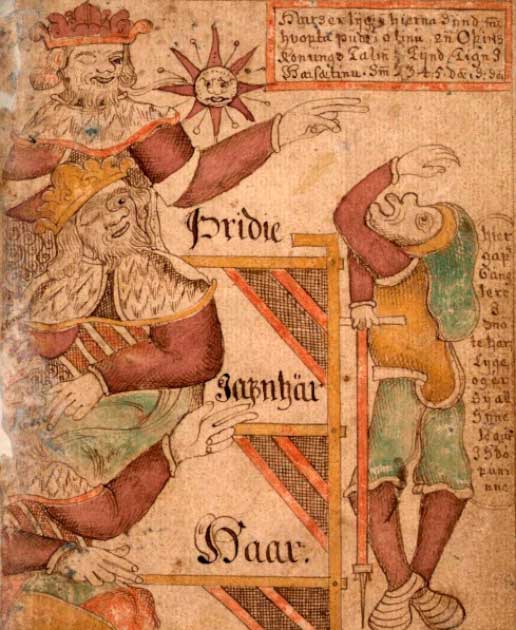
In the Prose Edda, Gylfi, King of Sweden before the arrival of the Aesir under Odin, travels to Asgard, questions the three officials shown in the illumination concerning the Aesir, and is fooled (18th-century Icelandic manuscript / Public Domain )
When Sturluson wrote about Ymir, he referenced the first text in the Poetic Edda, called the Völuspá. It stated that before the creation of the known universe, there was nothing but a void, probably full of magic. There was also an icy realm known as Niflheim, the source of eleven (or twelve) rivers. The text also mentioned Muspelheim, which was a boiling hot realm.
Sturluson also took inspiration from two other poems in the Poetic Edda, called Vafþrúðnismál and Grímnismál . Both are rather encyclopedic in nature and are filled with names and facts, rather than stories.
Vafþrúðnismál is comprised of a conversation between Odin (the most powerful Norse God) and a giant named Vafthrudnir. The aim of the conversation was to figure out who was wiser. In order to come to a conclusion, they discussed the creation of the known universe. Vafthrudnir mentioned the story of Ymir, and stated that the earth came from his flesh. Vafþrúðnismál also mentioned a character by the name of Aurgelmir. Historians today think this was probably another name for Ymir, because Vafthrudnir gave him the same creation story as Ymir.
Grímnismál told the story of Odin’s mistaken torture by a king unaware of Odin’s identity. Odin had a conversation with the king’s son, whose name was Agnar. During the conversation, Odin retold the story of the creation of the universe, and mentioned Ymir.
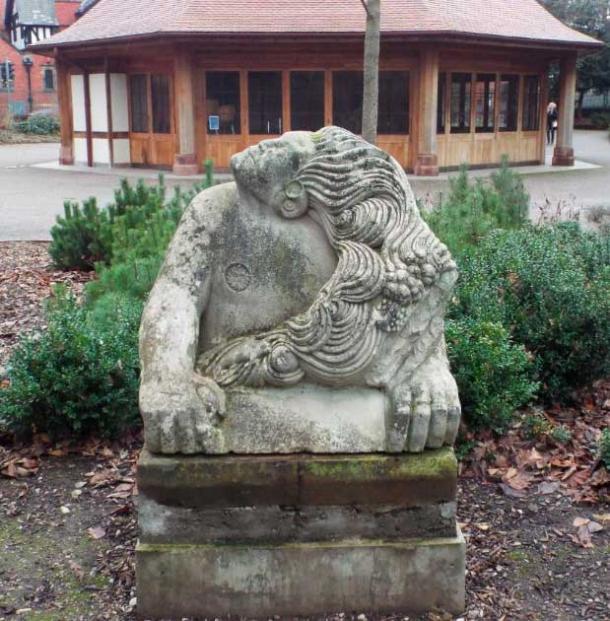
A stone statue of Ymir in St. Johns, Chester, United Kingdom (Hooligan / CC BY SA )
The Tales of Ymir in Norse mythology
According to Sturluson, Ymir was created when the rivers from Niflheim froze, causing ice to form in the void. This ice was then met by heat waves forming in Muspell. As the ice melted, it formed the shape of a man: Ymir. Ymir would become the first giant. He was therefore the ancestor of all giants, and by extension, many of the Norse gods. In some records, the void where Ymir is formed is given the name Ginnungagap.
In order to stay alive, Ymir suckled a cow named Audhumla. This cow had also been formed by the convergence of ice and fire between the two realms. When Ymir had had his fill, he slept. While he slept, his offspring formed from his sweat. A male and a female took shape under his armpit, and from his legs came a six-headed son.
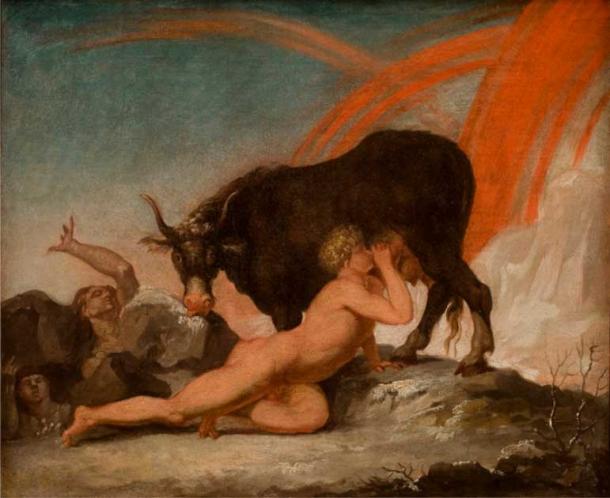
In Norse mythology, Ymir suckled the cow Audhumla at the dawn of the gods. Painting by Nicolai Abildgaard, 1777 ( Public Domain )
To nourish itself, the cow Audhumla licked the salt from a rock. From this rock, a man named Buri was revealed, who would be the first of the Aesir gods . On the first day, his hair was exposed, on the second his head, and on third, he was completely revealed.
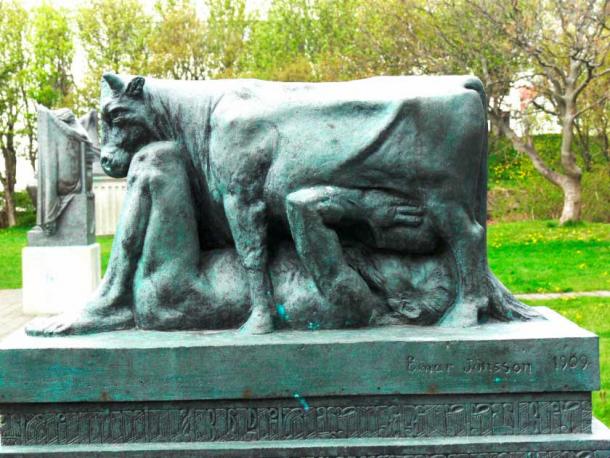
Sculpture of Ymir and Auðhumla, by Icelandic sculptor Einar Jónsson, 1909 (Christian Bickle / CC BY SA 2.0 )
Buri produced a son named Borr, who then mated with a giantess named Bestla, a descendant of Ymir. Together they produced the chief of the Aesir, Odin, as well as his two brothers Vili and Vé. Although little is known about Vili and Vé, Odin would go on to become one of the most famous Norse gods. He held the highest seat in the divine world. Odin was worshipped by everyone and was often linked to attributes like leadership, wisdom, strength, and sorcery.
The brothers Odin, Vili, and Vé destroyed Ymir, and created the universe from his very essence. The Grímnismál recorded the grisly events. The gods put Ymir’s body in the void ( Ginnungagap), and used his body to form the Earth and natural elements. For example, they used his teeth to make stones. From the Grímnismál:
From Ymir’s flesh the earth was created,
And from his sweat the sea,
Mountains from bone,
Trees from hair,
And from his skull the sky.
And from his eyebrows the blithe gods made
Midgard, home of the sons of men
And from his brains
They sculpted the grim clouds.
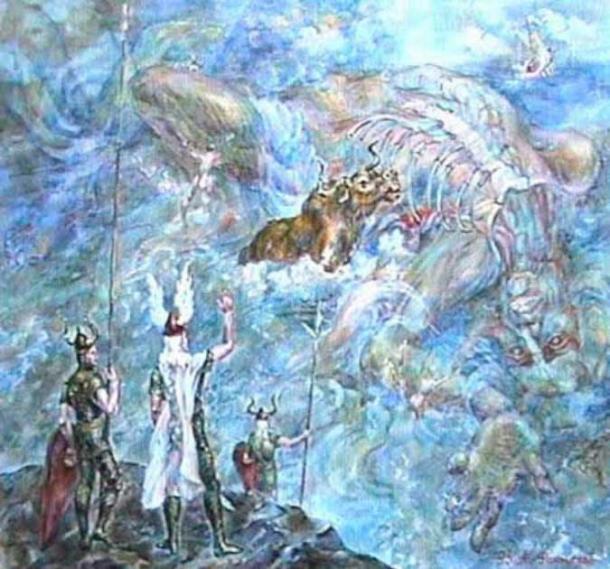
Odin, Vili and Ve killed Ymir and created the world of Midgard from his body (Sokol_92 / CC BY SA 3.0 )
Midgard was the realm where humans lived in Norse mythology, and its border was formed by Ymir’s eyebrows. To create the stars, the gods took sparks that flew out of Muspelheim and cast them into the sky. They then fixed their courses.
When a flood of Ymir’s blood (or, in some versions, sweat) formed the sea, all the other frost giants perished, except one couple, Bergelmir and his unnamed wife. They managed to survive by building an ark, on which they found refuge to re-establish the frost giant race.
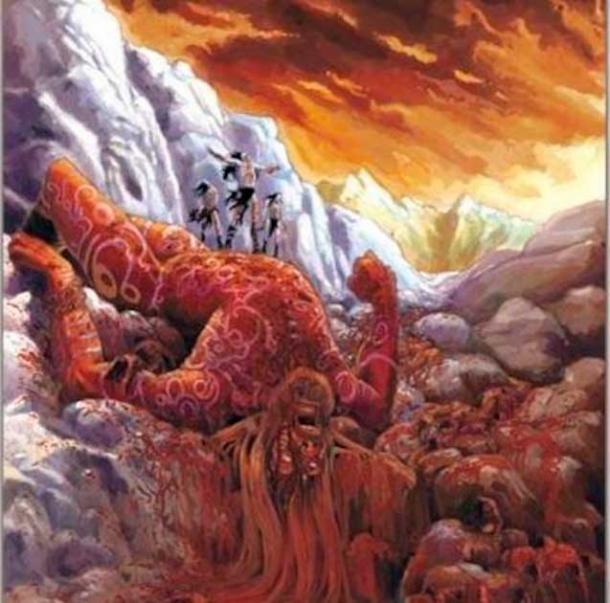
After Odin and his brothers kill Ymir in Norse mythology, rivers of blood enable human life to arise (PlasmaCommentates / CC BY SA )
Some sources stated that Odin and his brothers then found two logs near the seashore, which they used to construct the first humans. One of the brothers gifted the pair life and the ability to breathe; another gave them consciousness and movement, and the last gave them the ability to speak, see, and hear. All humans that would follow could be traced back to this pair.
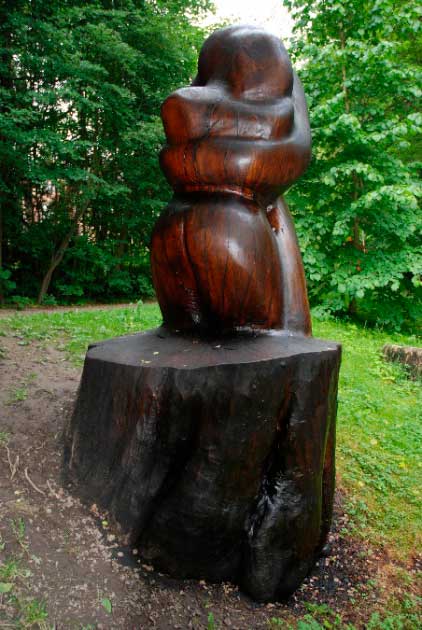
Carving of Ask and Embla, the first humans (Bengt Oberger / CC BY SA 3.0 )
While the gods were creating the universe, they had left the heavens in darkness. After a couple of generations, two beautiful descendants of those original two humans were born. These stunning children were gifted with the names Sol and Mani. The gods were jealous of the father of these children, and when they deemed him to be inadequate, they stole the children.
The gods then placed the children in the sky. Sol was instructed to drive a chariot to pull the sun across the sky. It was said that she traveled so quickly because she was chased by a giant wolf. Mani then followed his sister across the sky in the same path, but he did not rush as she did.
During the creation of the universe, the gods also created a pathway between the heavens and Earth. This pathway took the form of a rainbow, and acted as a bridge between the two realms.
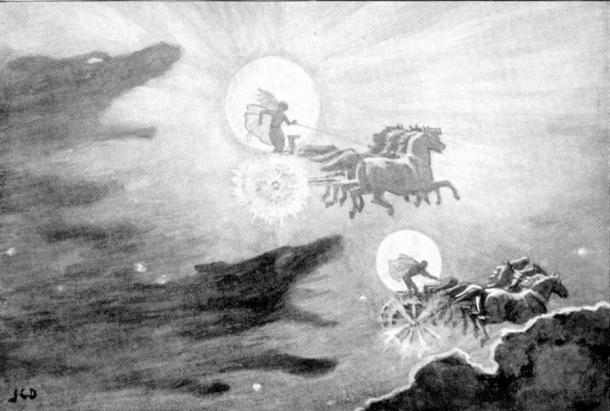
Wolves are said to chase Sol and Mani across the sky. Painting by John Charles Dollman, 1909 ( Public Domain )
Similarities between Ymir and other Ancient Mythological Characters
Ymir was a hermaphrodite, both mother and father to his offspring. In this sense, Ymir is similar to other ancient mythical characters. In Zorvanite Zoroastrianism, for example, the god Zorvan is both mother and father to a set of twins, named Ahura Mazda and Angra Mainyu . The twins went on to create the universe. In the ancient Indian Rigveda, there is a story of a being named Purusha. In this tale, Purusha is also cut up and sacrificed in order to form the known universe.
Comparative mythologist Michael Witzel has pointed to some similarities between Ymir’s story and those from South Asian mythologies. An example is the giant named Pangu, who emerged from a cosmic egg and formed the Earth, as well as the race that then populated it.
There are some other, more tenuous comparisons. In Kashmiri mythology, there is a giant demon named Rakshasa. Rakshasa is killed, and a river embankment is built from his remains. Another example is the Māori god Tangaroa, who created the universe from a shell he opened.
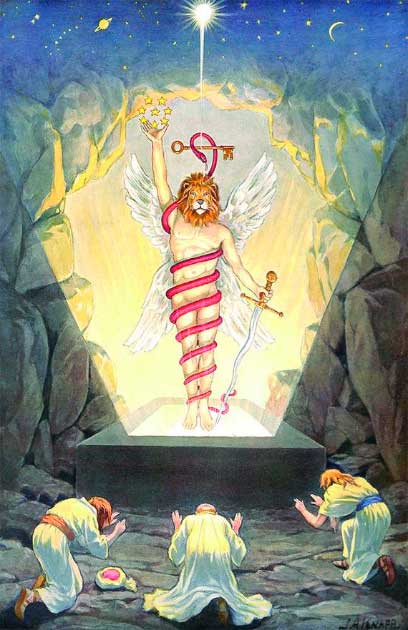
Zorvan, the Zoroastrian god of light and time, has similarities to Ymir in Norse mythology (Angaremino / CC BY SA 4.0 )
The Theme of Sacrifice in Norse Mythology
The theme of sacrifice is common, not only in the wider world, but also in other Norse mythological stories. Many of the gods are scarred from violent sacrifices they endured for the sake of the wider world. Perhaps the most striking example is Odin’s missing eye , which he surrendered in order to see the future and the trials of humanity. Additionally, Tyr sacrificed his hand to obtain the servitude of the giant wolf Fenrir.
Ymir’s Lessons and Legacy in Art and Culture
The story of Ymir has a narrative connection between the sacrifice of something or someone and the creation of the universe. This sacrificial relationship is central to in Ymir’s myth, because only through Ymir’s death could humans come into existence. Ymir’s blood (or sweat) drowned the old giants and paved the way for human life on Earth, and his hair became the vegetation of the land that nourished the human body. This is perhaps also referencing the cycle of life and death, which occurs every year in nature on a much larger scale.
To many, the frost at the beginning of the tale is meant to symbolize hardship, much like the rough Nordic winters the audience for these myths endured. From this hardship rose life. In this sense, some also believe that Ymir’s death was intended to be representative of the taming of the wilderness.
Ymir’s story speaks to the unstoppable force in humans, which was necessary for the creation of the universe, and has been necessary for our progress since. Ymir’s death can also be seen as a metaphor for the destruction leading to the creation of something truly beautiful and awe-inspiring.
In artwork, Ymir is typically depicted alongside his cow, considered his main symbol. The two became companions over time, and Audhumla remained a source of nourishment for Ymir. His ill-fated battle with the gods has also been a frequent source of artistic inspiration.
Unfortunately, Ymir’s legacy does not reflect his importance in the creation of the universe. Today, he is not nearly as recognized as other figures from the Norse myths. One of the few, yet most famous, depictions of the giant is in the Marvel Comics Universe, where there is a character with the same name. There he is depicted as a giant formed entirely of ice, whose goal is to destroy all life on Earth.
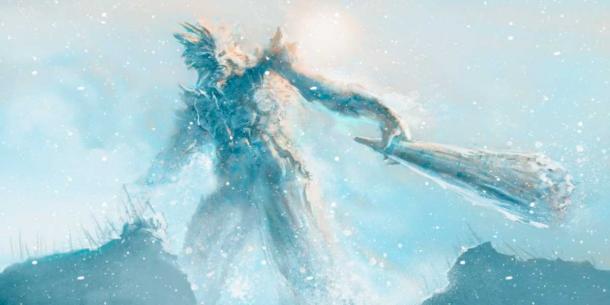
Marvel’s depiction of Ymir as an ice monster bent on world destruction has little relation to his role in Norse mythology (Fantasy Art / CC BY NC ND 2.0 )
Nevertheless, the Norse creation myth presents an interesting tale which glorifies sacrifice for the greater good. Because of this, it was deemed important for many of the Norse people and has stood the test of time.
Top image: Odin and his brothers defeated Ymir in Norse mythology, and used his body to create Midgard. Odin’s symbol, a raven, seen superimposed on a cosmic background. Source: jozefklopacka / Adobe Stock
By Molly Dowdeswell
"creation" - Google News
October 08, 2022 at 08:55PM
https://ift.tt/0Gdqtjs
Ymir in Norse Mythology: A Cosmic Creation Story - Ancient Origins
"creation" - Google News
https://ift.tt/t5GlD6R
https://ift.tt/oyZwhnm
Bagikan Berita Ini














0 Response to "Ymir in Norse Mythology: A Cosmic Creation Story - Ancient Origins"
Post a Comment